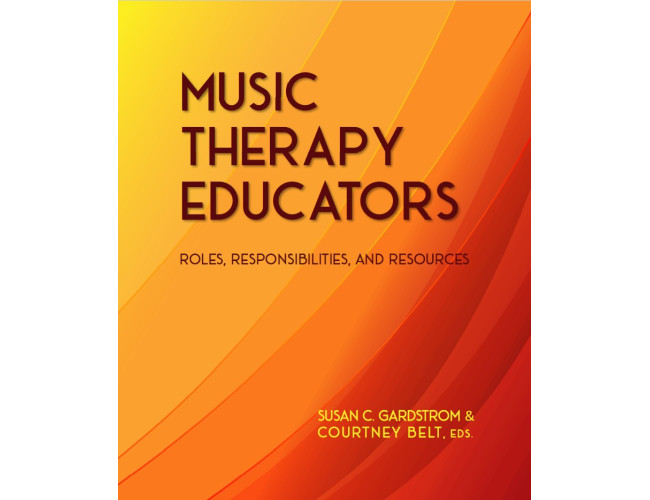Music Therapy Educators: Roles, Responsibilities, and Resources
- Author: Gardstrom, Susan C.; Belt, Courtney
- ISBN: 9781945411892
- E-ISBN: 978-1-945411-
Over 30 past and present
music therapy educators have joined forces to realize Music Therapy
Educators: Roles, Responsibilities, and Resources, a textbook whose
purpose is to update and supplement existing literature on undergraduate music
therapy education and training in the United States. Authors hail from public
and private institutions throughout the country and represent various philosophical
and “on the ground” perspectives on music therapy education. The book is
intended as a practical resource for a broad audience, including graduate
students who may enter academia after completing their degrees, clinicians
already possessing a graduate degree who are considering a career shift into
higher education, and current educators who may be seeking information and
support for their work.
The book is organized into three units. The first of these provides an overview of various academic opportunities, with detailed descriptions of common music therapy academic positions, such as Lecturer and Tenure Track Faculty. Descriptions of volunteer clinical opportunities are also included. The final chapter in Unit One addresses collegiality -- how it may manifest and be nurtured among and between members of the academy. Unit Two has as its focus the development and well-being of the music therapy educator, beginning with authors’ personal narratives describing factors influencing their decision to become an academic and their experiences of transitioning into this role. Additional chapters in this unit highlight ethical obligations, the development of the educator's pedagogical approach, and strategies to help educators manage burnout and maintain health and balance. Unit Three comprises 10 chapters, beginning with an introduction to the tenets and challenges of competency-based education and continuing with a focus on curriculum and course development and delivery, with topics such as course design, syllabus construction, and assessment of student learning and grading. Unique to this textbook, two chapters in Unit Three spotlight music therapy students -- their perspectives on education and their safety during curricular self-experiences. Two chapters about supervision as a key aspect of education and training conclude this unit. The culminating chapter of Music Therapy Educators: Roles, Responsibilities, and Resources considers several possible future “visions” of music therapy education and training in the United States.
Contents
Preface, by Susan C. Gardstrom and Courtney Belt
The Need for This Book
Intended Audience and Use
Organization of the Book
Situating the Editors
Language and Writing Choices
Contributors
References
UNIT ONE: Educator Roles and Responsibilities
1 Overview of
Academic Opportunities, by Courtney Belt
Non-Faculty Instructional Opportunities
Thesis and Dissertation Advising
Faculty Instructional Opportunities
Research Positions
Administrative Roles
References
2 Adjunct Faculty, by Debbie Bates,
Rachel Maurer, and Nathan Mensah
Adjunct Faculty Roles
Eligibility Requirements
Search and Selection Process
Employment Contracts
Primary Responsibilities of Adjunct Music Therapy
Faculty
Potential Benefits of Adjunct Positions
Potential Drawbacks of Adjunct Positions
Sociocultural Considerations
Unique Challenges
Closing Thoughts
References
3 Lecturer, by Courtney Belt
Teaching
Supervision
Course Design
Service to the Department
Miscellaneous Responsibilities
Potential Benefits of a Lecturer Position
Potential Drawbacks of a Lecturer Position
Closing Thoughts
References
4 Tenure-Track and Tenured Faculty, by Susan C.
Gardstrom
Potential Benefits of a Tenure-Track or Tenured
Position
Potential
Drawbacks of a Tenure-Track or Tenured Position
Eligibility and Selection
Contract and Rank
Applying for and Achieving Tenure
Sociocultural Considerations
The Future of Tenure
Closing Thoughts
References
5 Clinical Faculty and
Clinical Coordinator, by Courtney Belt and Sarah Hameline
Clinical Faculty/Professor of Professional Practice
Clinical Coordinator
Closing Thoughts
References
6 Academic Program Director, by Susan C. Gardstrom
Curriculum Development and Oversight
Marketing and Student Recruitment
Auditions and Acceptance
Academic Advising
Internship-Related Duties
Personnel
Miscellaneous Responsibilities of the Director
Closing Thoughts
References
7 Internship Director, by Rita Antonia
(Rich) Abante Moats
Importance of the Internship Experience
Types of Internships
American Music Therapy Association National Roster
Internships
University-Affiliated Internships
Administrative and Operational Responsibilities
Supervision Considerations
Closing Thoughts
References
8 Collegial Relationships, by Debra Jelinek
Gombert and Laura Pawuk
Author Positionality
Defining Collegiality
Benefits of Collegial Relationships
Collegial Relationships Relevant to the Music Therapy
Educator
Collaborative Endeavors with Colleagues
Contributing
Expertise
The Value of Differences
Institution-Wide Challenges to Collegiality
Power Differentials and Academic Hierarchies
Shifts in Academic Roles

